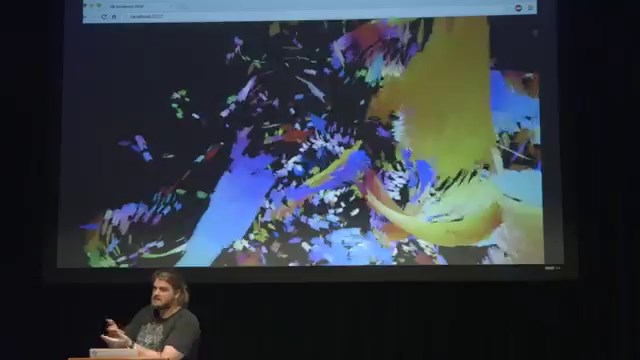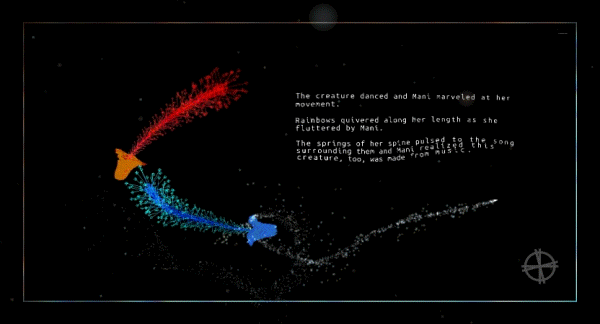What makes a collection of pixels into a magic experience? The art of storytelling. At the latest VRLA Summer Expo, creative coder Isaac Cohen (aka Cabbibo) shared his love for the human possibilities of virtual reality, digital experiences, and the power of hugs.
Isaac opens the talk by thinking about how we create the representation of 3D space in the digital world of ones and zeros – a place where nothing really exists, but everything is possible. Just connecting a series of one-dimensional dots can create a line, a plane, a fractal, or even things completely outside our everyday understanding.

He then dives into the dimension of storytelling through crafting and chaining together imaginary objects, and how perspective can be emotionally powerful. Like climbing to the top of a mountain and seeing how everything in your world is interconnected, depth and perspective can take experiences to an emotional, visceral level.
Isaac’s imagination is synesthetic, combining music and visuals in multiple dimensions. Pulsing space creatures with shimmering tendrils. Psychedelic jellyfish created from the structure of sound. Living comets around a dying star. It’s possible to give these creatures life within a graphics card, and expression through a web browser, but it’s the connections between them which gives them meaning.
“This allows the opportunity to tell more in that story. To provide more depth. To provide more perspective. To let people rise above the void that separates them from other people, walk around that, and give their homie a hug. That’s what we have to strive for – let humans be more human with other humans in a more real way.”
At this point, Isaac travels to the desolate world of Pulse, where users can connect points and create dimensions themselves as the story progresses. The world starts dark, with a rigid circuit board city and a distant moon, but springs to incredible life. (Isaac’s journey through the world of Pulse starts at 18:21.)
“It’s like giving someone the opportunity to participate in that movement between dimensions, because it is so, so, so much more magical… to be inside there. The object is used to provide a context to other objects, to create a scene. But then somehow you can use a bunch of scenes to provide context for each other to make a story.”
During the second half of the talk, he turns to one of his latest projects – Enough, a children’s storybook in WebGL. From the foreword:
“It’s difficult to describe the joy that I found from picking up a picture book and reading it cover to cover. They let me explore galaxies, ride dinosaurs, slay dragons. They let me dig deep down into my own being as I wished upon a magic pebble, boarded a train bound for the north, or soared through the sky on a plane made from dough.
“I know I can never recreate the splendor, magnificence, or beauty that I found in these majestic works, but I hope that this project will still remind you of the wonder you found in these moments. Those times when you could be anything, go anywhere, and find magic in the most fragile of places.”

Whether it’s a movie, a game, or a story around a campfire, storytelling works by building and bridging scenes to create a narrative thread. And when everything comes together, it’s nothing short of magic.






Well it looks like this may be THE man with a plan. BUT… The Hao Li howly woolen vee arrr vase o’ Lean (David Lean) the facial recognition contextual weight overlay is too in-your-face.
A bunch of mistakes are being made here due to a lack of understanding of social context… A person or people’s place in history.
The silhouette is meant to give me the impression of a shamans fireside chat. Or fdr. The IMPLIED Hitler moustache using shadow to infer that this man is a national empire renaissance man class leader isn’t subtle and won’t have the desired effects… Hitler’s place in history is muddy at best.
The overall pre-sapiens perceived neanderthal or cro.magnon proportions IMPLIED by silhouette are of no use without visible sapiens morlock reference visible. The overlay hurts this man and his cause which is unfortunate because his ideas are Pantheon class.
September 13, 2015 at 12:54 amAlex… You totally shouldn’t consider this as me telling you to email a primate infant > human toddler > human child > adolescent fkuctard math and coding and mind flow chart interpreting prospectus which we could get the money to work on in Canada via an SBLA loan or something like that. For the startup.
For global scale rollout… You’ll need Pantheon class backing. Email the gates foundation a copy when you mail one to me…
Healingshoes@gmail or leetanghang.Kwan.yin.yang at gmail
September 13, 2015 at 1:03 am[…] Source link […]
January 8, 2018 at 8:30 am